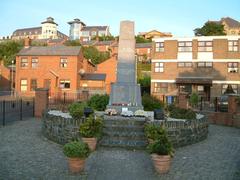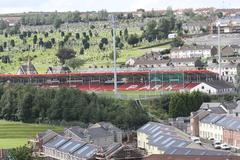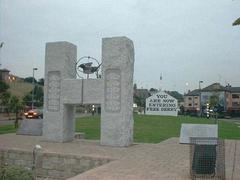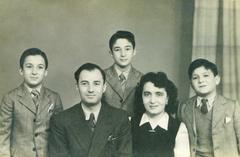Creggan, Derry, United Kingdom: Visiting Hours, Tickets, and Historical Sites Guide
Date: 04/07/2025
Introduction: The Heart of Creggan
Creggan, perched on the western heights overlooking Derry city, is a neighborhood that weaves together centuries of history, cultural resilience, and vibrant community life. From its 6th-century monastic roots to its central role in Northern Ireland’s Troubles, Creggan stands as a living testament to Derry’s complex heritage (Derry Journal). Today, it offers visitors a unique combination of historical landmarks, evocative murals, dynamic community centers, and panoramic views of the River Foyle.
This guide provides detailed insights into Creggan’s evolution, essential visitor information, and tips for exploring its most significant sites. Whether you’re a history enthusiast, a cultural explorer, or simply seeking a meaningful experience in Derry, Creggan invites you to delve into its remarkable story.
Historical Evolution of Creggan
Early Origins and Monastic Foundations
Creggan’s roots stretch back to the 6th century when St. Columba (Colmcille) established a monastic settlement in Derry, laying the foundations for a spiritual and educational hub that shaped the region’s character (Derry Journal). The influence of early Christianity endures in local traditions and place names, making Creggan a site of continuous spiritual significance.
Medieval and Early Modern Developments
By the late middle ages, the O’Neill Gaelic clan had established dominance in the area. The construction of churches and fortified sites, including what would become the Creggan Parish Church, underscored the region’s importance as a cultural and political stronghold (Visit Mourne Mountains). The Plantation of Ulster in the 17th century and the building of Derry’s city walls initiated long-standing divisions, but also left a rich architectural legacy (Derry Journal).
19th & 20th Century: Urbanization and Social Change
Through the 19th century, Derry became an industrial hub, though Creggan remained largely rural until the post-war era. The Great Famine and subsequent migration reinforced the city’s Catholic majority, setting the stage for the political complexities of the 20th century (Derry Journal).
Post-War Expansion and the Birth of Creggan Estate
In response to severe overcrowding and poor conditions in Derry’s center, the Creggan housing estate was developed in the late 1940s to accommodate working-class Catholic families. This urban expansion fostered a strong sense of community identity and established key institutions like St. Mary’s Parish (St Mary’s Parish Creggan).
The Troubles: Conflict, Community, and Resilience
Creggan became synonymous with resistance during the Troubles, serving as a focal point for civil rights activism, and witnessing intense confrontations and tragedies such as Bloody Sunday (The Conversation; BBC News). Despite hardship and military presence, the community developed a profound spirit of solidarity and self-reliance (Derry Journal).
Regeneration and Contemporary Identity
Since the 1990s, Creggan has undergone significant regeneration. Initiatives like Creggan Enterprises and the Ráth Mór Centre have fostered economic development and social inclusion. The area is celebrated for its literary and artistic heritage, Gaelic poetry, and annual community events (Visit Mourne Mountains).
Key Visitor Information
Opening Hours & Tickets
- St. Mary’s Church & Graveyard: Open daily, 9:00 AM – 5:00 PM. Free entry. Contact the parish (website) for seasonal changes or guided tours.
- Creggan Country Park: Open daily, 9:00 AM – 6:00 PM. Entry is free; fees apply for activities like canoeing and paintball (Creggan Country Park Official Site).
- Cultural Venues: Hours vary; check with individual centers like Creggan Arts Centre (Creggan Arts Centre) for event details.
Accessibility
Most major sites are partially or fully accessible, though terrain around graveyards and older structures can be uneven. Contact venues in advance to confirm details.
Getting There
Creggan is accessible by car, bus, or taxi from Derry city center. Parking is available near St. Mary’s Parish and Creggan Country Park. Public transport is recommended due to limited residential parking.
Top Historical and Cultural Sites
St. Mary’s Church
The spiritual heart of Creggan, St. Mary’s Church is central to the community’s history and was the site of funerals for Bloody Sunday victims. Guided tours are available by appointment (St Mary’s Parish Creggan).
Creggan Estate Murals
Powerful political murals commemorate key events from the Troubles, such as the Battle of the Bogside and Bloody Sunday. Guided walking tours are recommended for respectful and insightful visits (BBC News).
Creggan Country Park
A 100-acre park with lakes, woodlands, and outdoor activities including angling, orienteering, and environmental workshops. Equipment rentals and guided tours are available (TripHobo).
Eastway Wall Murals & Memorials
The Eastway Wall features murals honoring Creggan’s resilience and commemorating the Troubles (In These Times). Memorials for Bloody Sunday victims surround St. Mary’s Church, serving as sites of reflection.
Nearby Attractions
- Derry City Walls: A UNESCO World Heritage candidate, offering panoramic city views (The Crazy Tourist). Guided tours available.
- Guildhall: Neo-Gothic architecture, exhibitions, and cultural events (Adventure Backpack).
- Peace Bridge & Ebrington Square: Modern symbols of reconciliation, open 24/7 (The Irish Road Trip).
- The Craft Village & Playhouse Theatre: Artisan shops, live music, and cultural programming (Wordpress Pleasantville).
- Derry Girls Mural: A popular photo spot celebrating local humor (Wordpress Pleasantville).
- Ness Country Park: Woodlands, waterfalls, and picnic areas, open year-round (The Crazy Tourist).
Festivals and Community Events
- Creggan 50th Festival: Community celebration of Creggan’s identity, with periodic street parties and gatherings (St. Mary’s Parish Creggan).
- Derry Halloween Festival: Major annual event featuring parades and fireworks (Northern Ireland Holidays).
- Derry Folk and Trad Festival: Music, dance, and workshops, including events in Creggan (Irish Star).
Travel Tips and Practical Advice
- Respect Local Customs: Creggan has a strong community identity; be sensitive when visiting memorials or photographing murals.
- Accessibility: Check with venues about wheelchair access, especially for older sites and trails.
- Safety: The area is generally safe and welcoming, but remain respectful around commemorative dates and avoid photographing residents without permission (BBC News).
- Best Time to Visit: Spring and early autumn offer pleasant weather and fewer crowds. Major festivals require advance planning (Adventure Backpack).
Frequently Asked Questions (FAQ)
Q: Are there entrance fees for Creggan’s historical sites?
A: Entry is generally free, including St. Mary’s Church and Creggan Country Park. Some activities or guided tours may require payment.
Q: What are the best times for photography?
A: Early morning and late afternoon provide the best light for panoramic views and murals.
Q: Is Creggan suitable for families?
A: Yes, with open parks, community centers, and family-friendly events.
Q: Are guided tours available?
A: Yes, local groups offer tours focusing on Creggan’s history, murals, and culture.
Q: Is Creggan accessible for visitors with disabilities?
A: Many sites are accessible, but some outdoor areas may be challenging; contact venues in advance for details.
Plan Your Visit: Explore and Stay Connected
Creggan’s rich history, dynamic cultural life, and enduring community spirit make it a must-visit destination in Derry. Enhance your experience by:
- Downloading the Audiala app for audio guides, maps, and insider tips.
- Following local organizations and Derry tourism on social media for event updates.
- Exploring related articles on Derry’s historical sites and cultural festivals.
References & Further Reading
- Derry Journal
- Visit Mourne Mountains
- The Conversation
- CAIN Ulster
- BBC News
- St Mary’s Parish Creggan
- Creggan Arts Centre
- Creggan Country Park Official Site
- TripHobo
- In These Times
- Wordpress Pleasantville
- Adventure Backpack
- Komoot
- The Irish Road Trip
- Northern Ireland Holidays
- Irish Star
Creggan stands as a living monument to Derry’s past and present—inviting every visitor to explore, reflect, and become part of its continuing story.



